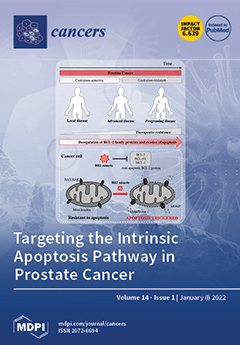Current anticancer treatments are inefficient against glioblastoma multiforme (GBM), which remains one of the most aggressive and lethal cancers. Evidence has shown the presence of glioblastoma stem cells (GSCs), which are chemoradioresistant and associated with high invasive capabilities in normal brain tissues. Moreover, accumulating studies have indicated that radiotherapy contributes to abnormalities in cell cycle checkpoints, including the G
1/S and S phases, which may potentially lead to resistance to radiation. Through computational simulations using bioinformatics, we identified several GBM oncogenes that are involved in regulating the cell cycle. Cyclin B1 (
CCNB1) is one of the cell cycle-related genes that was found to be upregulated in GBM. Overexpression of
CCNB1 was demonstrated to be associated with higher grades, proliferation, and metastasis of GBM. Additionally, increased expression levels of CCNB1 were reported to regulate activation of mitogen-activated protein kinase 7 (
MAPK7) in the G
2/M phase, which consequently modulates mitosis; additionally, in clinical settings,
MAPK7 was demonstrated to promote resistance to temozolomide (TMZ) and poor patient survival. Therefore,
MAPK7 is a potential novel drug target due to its dysregulation and association with TMZ resistance in GBM. Herein, we identified
MAPK7/extracellular regulated kinase 5 (
ERK5) genes as being overexpressed in GBM tumors compared to normal tissues. Moreover, our analysis revealed increased levels of the cell division control protein homolog (
CDC42), a protein which is also involved in regulating the cell cycle through the G
1 phase in GBM tissues. This therefore suggests crosstalk among
CCNB1/CDC42/MAPK7/cluster of differentiation 44 (
CD44) oncogenic signatures in GBM through the cell cycle. We further evaluated a newly synthesized small molecule, SJ10, as a potential target agent of the
CCNB1/CDC42/MAPK7/CD44 genes through target prediction tools and found that SJ10 was indeed a target compound for the above-mentioned genes; in addition, it displayed inhibitory activities against these oncogenes as observed from molecular docking analysis.
Full article






